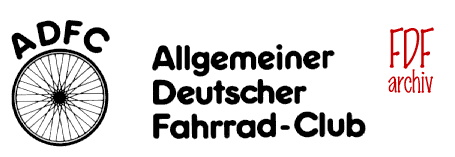
Bicycle Research Service: ForschungsDienst Fahrrad
FDF 136 - 09.03.1991
BURKHARD HORN:
FROM THE DECLINE OF A MEANS OF MASS TRANSPORT TO THE HISTORY OF URBAN CYCLE PLANNING
National Socialist traffic planning introduced the exclusion of cycle traffic
Key points: Mass motorization was part of the propaganda of the National Socialist regime. Both during and after the regime, largely the same people and organizations had significant influence on the guidelines for cycle planning in Germany. Even after the war, the construction of cycle tracks was based on giving priority to motorized traffic so that lanes freed of cyclists would be available for mass motoring.
Main content: Cycle planning in Germany has developed in distinct phases according to "The history of urban cycle planning" a thesis written by Burkhard Horn of the Comprehensive University of Kassel Even before the First World War, the bicycle went from being the sports equipment of the upper classes to the daily transport mode of the worker The 1920s saw the rise of the bicycle to become a mass mode of transport Until the 1950's the bicycle was able to hold its own, after that a sudden decline began It was not until the middle of the 1970s that there was a gradual revival in bicycle use
Discussions on cycle tracks began as far back as 1890 These early discussions demanded separate cycle lanes or cycle tracks and cited the endangerment of pedestrians, dangers due to horses taking fright or the risk of accident due to careless cyclists as their justification
The first cycle tracks were constructed in Bremen in 1897 Hanover followed in 1989 and there were extensive plans for Hamburg as early as 1899
The theoretical basis for the further construction of cycle tracks in Germany can be attributed to single individuals In the 1920s the Magdeburg Urban Construction Officer, Henneking, contributed considerably In the 1930s, 40s and 50s the traffic engineer, Hans Joachim Schacht, also played an important role
In 1926, Henneking drafted the first proposals for "the construction of cycle tracks" for the bicycle as a mass means of transport on behalf of the Association of German Bicycle Producers
Drawing on his influence, the Study Group for the Construction of Roads for Automobiles (STUFA) compiled the first "Guidelines for Cycle Tracks" in 1927 These guidelines took into consideration the needs of cycle traffic and considered how the fundamental separation of different types of traffic could be achieved in the interest of automobile traffic However, Henneking felt the value of 1.5 metres recommended by STUFA for bi-directional cycle tracks was too narrow (he recommended between 2 and 2.75 metres.)
The overestimation of the efficiency of narrow cycle tracks and the turn away from cycle lanes marked on the roadway can be attributed above all to Schacht In his 1933 thesis for the Technical University of Dresden, Schacht used arguments regarding road safety and efficiency to justify the "removal of cyclists from all roads on which fast traffic played a significant role" as well as recommending a standard width of 1m for one-way cycle tracks In his role as the director of the "Committee for cycle track construction", which was attached to the National Socialist apparatus, Schacht was involved from 1934 onward in the increased promotion of the construction of cycle tracks because they were necessary for both the mass motorisation that was being proposed and to help combat unemployment In 1936/1937 he commissioned the "Guidelines for the construction of cycle tracks."
Even after the war, Schacht advocated the concept that cycle track planning must be subordinated to planning for automobile traffic In 1952 "guidelines" were compiled under his influence in his role as district works leader for STUFA; by now the Roads Research Institute (FGS) In 1961 the bicycle and pedestrian traffic committees of the FGS were combined into one The goal of cycle track planning became the unhindered travel of motorists For example, "disturbances" such as those caused by cyclists at junctions were to be eliminated (Source: 1963 Preliminary Guidelines for Cycle Traffic Facilities.) In 1982, as the revival of cycling was becoming more and more evident, the committee published the relatively non-binding "Recommendations for the planning, construction and operation of cycle traffic facilities." These recommendations placed greater emphasis on cycle-network planning and the significance of bicycles as a mode of transport
There are many varying points of view on the future of cycling One side argues that the bicycle can once more achieve greater significance as a fully-fledged mode of transport if it is allied with public transport It also promotes the idea of being able to walk and linger on city streets and does not support restricting this in favour of cycle traffic Admittedly the image that has emerged of the cyclist as a "kind of pedestrian" must be corrected The objectives of "demerging" and "unmixing" must also become less important In opposition stand influential traffic planners such as Konrad Pfundt, head of the automobile insurers' centre for accident prevention, who does not support what he terms "unconventional" planning or any "ideologies" that justify hindrances to motorized traffic
Thesis: "From the decline of a means of mass transport to the history of urban cycle planning", Comprehensive University of Kassel, Department of Town Planning and Landscape Architecture 1990
Author: Burkhard Horn
(Translated by Shane Foran Jan 2004 with some help from friends in Germany)
Until 1999, the ADFC's Bicycle Research Service published reports on traffic issues and cycle politics on a fortnightly basis Many thanks to Tilman Bracher, Mattias Doffing and to Elmar Steinbach, who have published these reports on the Internet
The Bicycle Research Service was discontinued mid-1999 It was superseded by the Bicycle Research Reports which can be subscribed from the ECF (www.ecf.com) European Cyclists' Federation ECF - Rue de Londres 15 (b 3) - B-1050 Brussels - Phone: +32-2-512 98 27 - Fax: +32-2-511 52 24, e-mail: mailto:office@ecf.com
